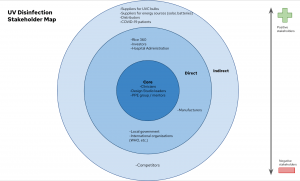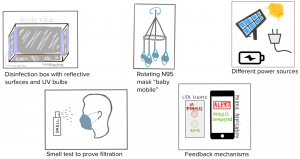We spent the week preparing for stakeholder interviews, which has filled me with anticipation — I’m excited to delve into not only technical but also interpersonal and communication skills and really make some of our ideas manifest in real life. Hannah and Aubrey led a workshop on Monday about presentation and writing tips, which forced me to reflect on my own communication style and its strengths and weaknesses. In all honesty, I expected the workshop to cover information I already knew, because I’ve gotten lots of advice on how to properly present from experiences in high school and college. But my communication skills have evolved over time, so it’s nice to get a mental check-in about how I can be better. As an example, while I know in theory that topic sentences should be extremely informative, I realized that I still have a tendency to make these sentences vague without realizing.
Later that day, our team had a Zoom meeting to discuss our stakeholder maps. We had brainstormed a list of general stakeholders, but we wanted to go into more detail and organize them based on how much each would interact with our design. To do this, we split them into three groups: core, direct, and indirect stakeholders. The core stakeholders are the people who are directly involved in the creation of the device (clinicians, the design studio leaders, the Rice 360 intern teams, etc.). Direct stakeholders were then classified as people who would have an interest in the design, but would not play a huge role in the creation of the device (investors, manufacturers, government organizations, regulatory bodies). Finally, indirect stakeholders were classified as people who would be important in the implementation of the device, but played no role in the design process (suppliers, COVID-19 patients, competitors, etc.). This mapping helped us immensely in visualizing the types of people we would need to talk to in order to ensure that our devices were both useful and could be completed to fruition.

On Wednesday, we had a workshop on sustainability led by Wayne Decker, the founder of the Flame Tree Initiative, an organization that fosters sustainable social enterprises that combat extreme poverty in East Africa. This was really insightful, and encouraged our team to have a deeper discussion on the power and energy sources we were using for these devices. Although the hospital I had been familiarized with was the Queen Elizabeth Hospital in Blantyre, I hadn’t truly focused on the majority rural setting of Malawi. The UVC disinfection system that we are working on currently relies on electrical power, and this workshop made us consider the cost of switching to solar — is the increase in price justified to switching to a sustainable energy source? Perhaps there isn’t a “one size fits all” solution — maybe the two separate settings necessitate wholly different systems.
After intense conversation and deliberation on how to best proceed, our team is now considering a two-system approach — one that is a smaller disinfection box that can be solar powered and can only hold around 10 masks for rural settings, and another that has a larger capacity and is grid or battery powered for urban settings. With this idea, our team documented some a lot of questions that were necessary to ask stakeholders, such as the number of masks they would want cleaned, and how much space in the hospital they could sacrifice for this sort of system.
Focusing on sustainability with our second prototype, the face shields, we mainly focused our discussion on using locally available resources. Based on this, we are trying to research local suppliers and manufacturers for the shield materials. By using local suppliers and manufacturers without outsourcing, the shields’ price will be significantly lowered. In looking for a replacement for the foam piece of the face shield, narrowing our search to local suppliers will be helpful in finding materials that we are sure are readily available.
On Friday, we had a presentation from Mr. Dumi Kaliati, which was incredibly inspiring. Dumi founded MicroMek, a startup that works to create drones to transport sterile medicine from the clinic to the laboratory, improving both diagnostics and reliability. He talked about his motivation for the project, and said that he was already developing prototypes and ideas for his company in his second year of undergrad. Here I am, having completed my second year of undergrad, still navigating college and figuring out what I want to do in life. Listening to his presentation, I gained so much respect and admiration for his drive and passion for his designs and his company. I’m grateful for just the opportunity to hear him speak. Dumi also was kind enough to give us feedback on our UVC disinfection device, where he mainly asked us to really hone in on who our target audience was. Based on that, he said that our design would have a more cohesive solution.

Reflecting on all we had learned earlier in the week, our team came together Friday afternoon to come up with a final list of questions for stakeholders in preparation for our interviews that start tomorrow. I’m so excited to get more feedback from our stakeholders, but I definitely feel a little nervous! Hopefully everything will go well, and by the end of next week we will not only have an idea of what we want the prototypes to look like, but also what the stakeholders would like out of these prototypes. Rice has given me both a theoretical and practical education, but I now need to take these skills and conduct interviews with thought leaders in the field– that requires something that’s harder to teach: confidence.
I wouldn’t be able to complete this blog without mentioning Team PPE’s win at the team scavenger hunt on Saturday! The TAs organized this really, really fun virtual scavenger hunt for the interns, and each team was playing against each other. The TAs gave each intern team a riddle for a common household item, and the teams would have to solve the riddle, take a selfie with the answer to the riddle, and then send it to the intern group chat. Let me be clear: Team PPE was determined. There was a lot of shouting, a lot of running around the house (shoutout to Andrew, Team PPE’s star runner), a lot of anxiety spikes, but a lot of fun! We were told we are going to get a “virtual prize” of some sort, but we are still waiting for an announcement of what the prize is.
Looking forward to next week, with a little nervousness but a lot of excitement. I can’t wait to dive into this project more in detail in this next half of the internship!
-Bhavya 🙂